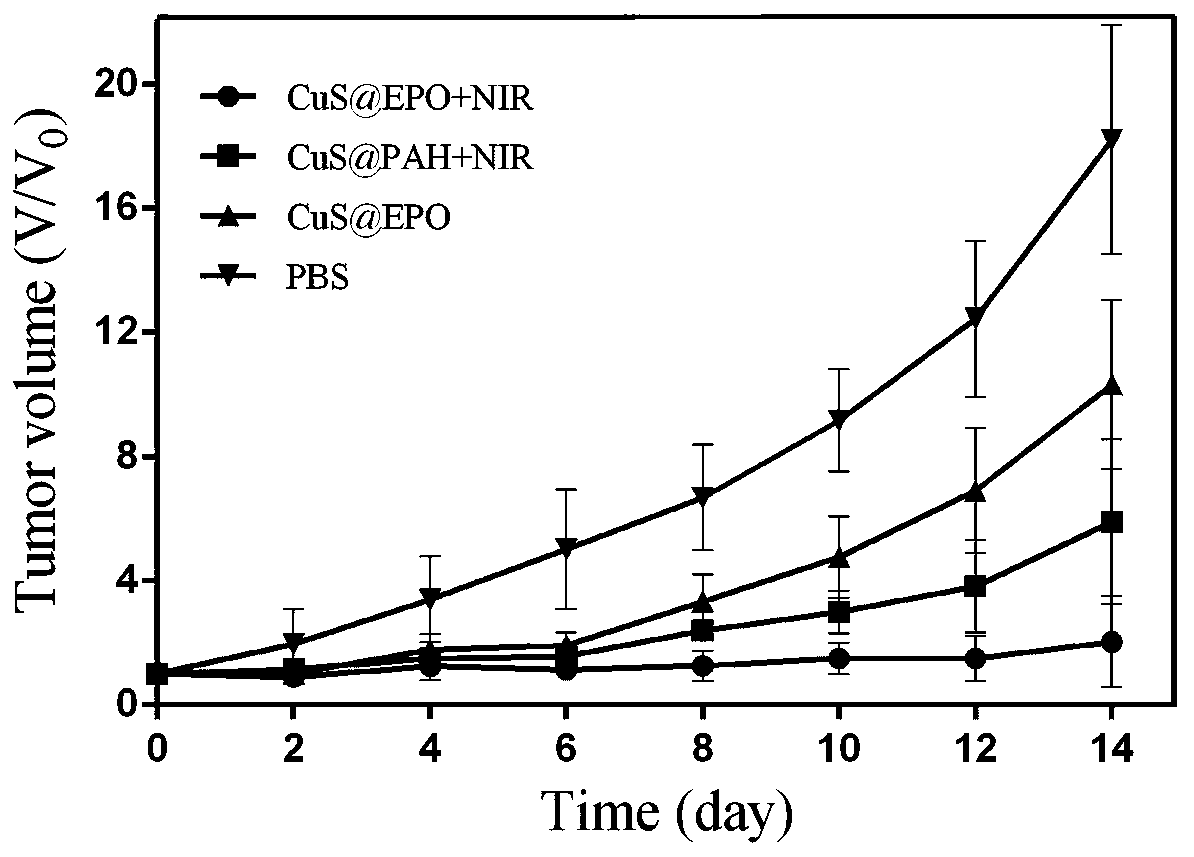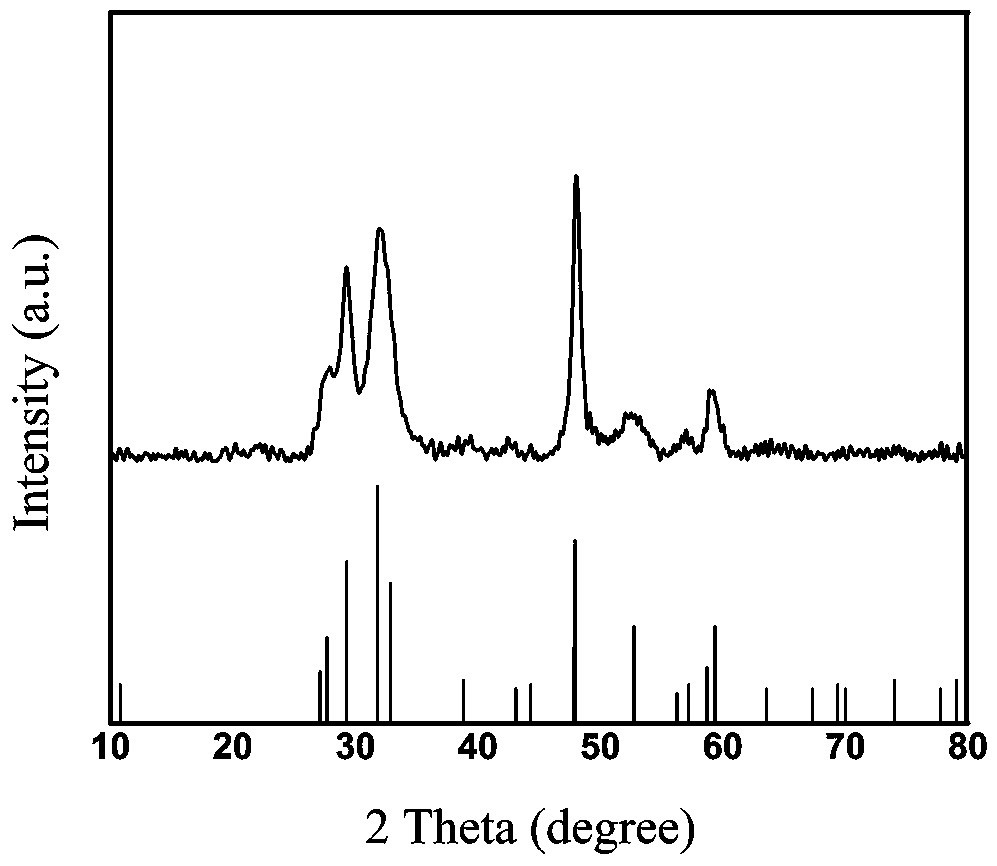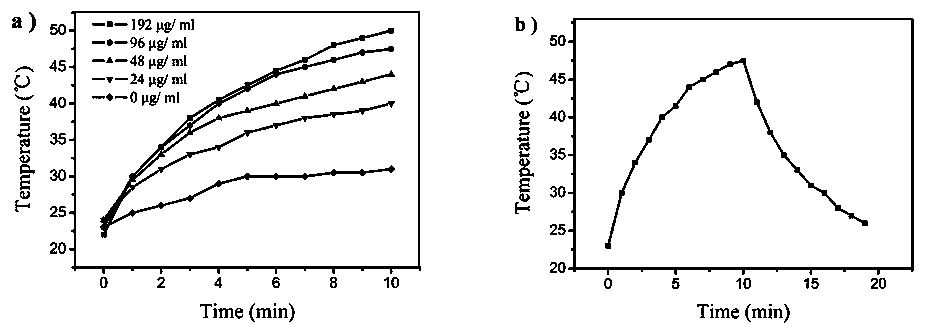Method for controllably synthesizing CuS@EPO nano material through electrostatic assembling
A nano-material, EPO-PAH technology, applied in the field of inorganic nano-functional materials, can solve problems such as unusable, high temperature requirements, poor photodynamic therapy effect, etc., to achieve the effect of reducing damage, enhancing therapeutic effect, and overcoming dependence on light source
- Summary
- Abstract
- Description
- Claims
- Application Information
AI Technical Summary
Problems solved by technology
Method used
Image
Examples
Embodiment 1
[0022] A method for controllable synthesis of CuS@EPO nanomaterials through electrostatic assembly, comprising the following steps:
[0023] (1) Take sodium citrate and copper chloride dihydrate in a round-bottomed flask filled with deionized water, stir magnetically at room temperature for 15 minutes, then gradually add aqueous solution of sodium sulfide nonahydrate to the above solution, and react at 89 °C for 20 min, to obtain an aqueous solution containing nano-CuS, then cool, centrifuge, wash, and store at 4°C; The particle size is about 20nm, and the concentration of copper chloride dihydrate is 1mol / L;
[0024] (2) After mixing 1-(3-dimethylaminopropyl)-3-ethylcarbodiimide hydrochloride and N-hydroxysuccinimide, add the carboxylated pyridone endoperoxidation synthesized in advance The aqueous solution of the product was stirred at 0°C for 1 h to carry out the activation reaction; then the polyallylamine hydrochloride after dehydrochlorination treatment was added, and t...
Embodiment 2
[0034] A method for controllable synthesis of CuS@EPO nanomaterials through electrostatic assembly, comprising the following steps:
[0035] (1) Take sodium citrate and copper chloride dihydrate in a round-bottomed flask filled with deionized water, stir magnetically at room temperature for 15 minutes, then gradually add aqueous solution of sodium sulfide nonahydrate to the above solution, and react at 95 °C for 20 min, the aqueous solution containing nano-CuS was obtained, then cooled, centrifuged, washed, and stored at 6 °C; the molar masses of sodium citrate, copper chloride dihydrate, and sodium sulfide nonahydrate were 5mol, 6mol:6mol, and the particle size of nano-CuS The diameter is about 30nm, and the concentration of copper chloride dihydrate is 1.2mol / L;
[0036] (2) After mixing 1-(3-dimethylaminopropyl)-3-ethylcarbodiimide hydrochloride and N-hydroxysuccinimide, add the carboxylated pyridone endoperoxidation synthesized in advance Stir the aqueous solution at 2°C ...
Embodiment 3
[0040] A method for controllable synthesis of CuS@EPO nanomaterials through electrostatic assembly, comprising the following steps:
[0041] (1) Take sodium citrate and copper chloride dihydrate in a round-bottomed flask filled with deionized water, stir magnetically at room temperature for 15 minutes, then gradually add aqueous solution of sodium sulfide nonahydrate to the above solution, and react at 90 °C for 20 min, to obtain an aqueous solution containing nano-CuS, then cooled, centrifuged, washed, and stored at 10°C; The diameter is about 20nm, and the concentration of copper chloride dihydrate is 2mol / L;
[0042] (2) After mixing 1-(3-dimethylaminopropyl)-3-ethylcarbodiimide hydrochloride and N-hydroxysuccinimide, add the carboxylated pyridone endoperoxidation synthesized in advance The aqueous solution of the product was stirred at 1°C for 1.2h to carry out the activation reaction; then the polyallylamine hydrochloride after dehydrochlorination treatment was added, an...
PUM
| Property | Measurement | Unit |
|---|---|---|
| particle diameter | aaaaa | aaaaa |
| particle diameter | aaaaa | aaaaa |
| particle diameter | aaaaa | aaaaa |
Abstract
Description
Claims
Application Information
 Login to View More
Login to View More - R&D
- Intellectual Property
- Life Sciences
- Materials
- Tech Scout
- Unparalleled Data Quality
- Higher Quality Content
- 60% Fewer Hallucinations
Browse by: Latest US Patents, China's latest patents, Technical Efficacy Thesaurus, Application Domain, Technology Topic, Popular Technical Reports.
© 2025 PatSnap. All rights reserved.Legal|Privacy policy|Modern Slavery Act Transparency Statement|Sitemap|About US| Contact US: help@patsnap.com



